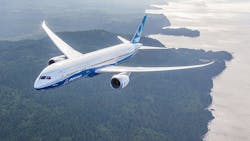Boeing Keeps Mum on 787 Output Boost as Wide-Body Jet Sales Slow
Boeing Co. just set a new production record for its 787 Dreamliner. But the U.S. planemaker is keeping mum, for now, on plans to speed output to an even faster pace as demand for wide-body aircraft shows signs of waning.
The U.S. planemaker has yet to decide when to boost the production rate to 14 Dreamliners a month, even with the popular carbon-fiber aircraft sold out through the end of the decade, CEO Dennis Muilenburg said June 2 at the Bernstein Strategic Decisions Conference in New York. That call depends on several pending sales campaigns for the plane, he said.
Boeing has been planning the next step up in 787 output for several years as Airbus Group SE prepares its own production increase for wide-body aircraft. Faster deliveries of Boeing’s largest and most profitable Dreamliner models would help the company absorb some of the $29 billion in deferred production costs accumulated during the aircraft’s troubled start.
“Fourteen-a-month is still where we’re heading,” Muilenburg said. “And we haven’t precisely defined the timing on that yet because it’s dependent on” the skyline, an aerospace term for planned monthly deliveries.
Production Record
The Chicago-based company reached a milestone last week by delivering to Japan Airlines Co. the first 787 built at an accelerated production tempo of 12 planes a month. That’s the fastest-ever assembly rate for a twin-aisle behemoth, used to ferry passengers on long-range flights.
Analysts have questioned whether Boeing would speed 787 production amid slower economic growth in key markets such as China and pricing signals from the secondary market that suggest a glut of wide-body aircraft. But Boeing also must counter faster output planned by Airbus for two planes that compete with the Dreamliner, the A330neo and A350neo.
“The risks of wide-body aircraft deliveries falling short of announced plans are more pronounced that some folks would appreciate,” Carter Copeland, an aerospace analyst with Barclays Plc said in a note to clients last month. “We think the prospects for the 787 getting to 14/month from 12/month are declining for sure.”
Retirement rates of long-range aircraft would have to stay well above the historical average of 3.6% to keep pace with planned twin-aisle deliveries by Boeing and Airbus, Sam Pearlstein, an aerospace analyst at Wells Fargo Securities, wrote in a June 1 report.
“If our traffic and production supply estimates are right, it would require a consistently above-average aircraft removal rate to align supply with demand,” Pearlstein said.
More Headwinds
Boeing faces similar headwinds as it tries to garner the 40 to 50 annual sales of its 777 jetliners needed to avoid disrupting suppliers and revenue as it shifts to the upgraded 777X model late this decade. Deliveries of the largest twin-engine jet will fall to 5.5 aircraft a month in 2018 and 2019, Muilenburg said, down from the current monthly pace of 8.3.
Boeing’s output of wide-body passenger models could be eclipsed by Airbus by the end of the decade because of lower output of the 777 and dwindling sales of the 747 jumbo jet, according to Pearlstein’s projections. The 777 is Boeing’s second-largest source of profit.
Boeing will make about 220 twin-aisle passenger jets this year with that total tapering to about 205 planes by 2019, Pearlstein said. Airbus’s output will rise to 250 over the same period from about 135 planes this year, he said.
About the Author
Bloomberg
Licensed content from Bloomberg, copyright 2016.
